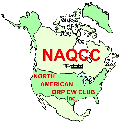
 | NAQCC News |
| Apr 28, 2012 | NAQCC Web Site | Issue #165 | |
|---|---|---|---|
|
In this issue: 1. May Challenge 2. April Sprint Results 3. General Club News 4. Chapter News 5. NAQCC Nets 6. CW Assistance (Elmer) Project 7. Latest Award and Prize Winners 8. Member Spotlight 9. News Items and Articles by Our Members |
| 1. MAY CHALLENGE: As the NAQCC membership continues to grow by leaps and bounds, having just reached 6,000 members, we have new 'situations' cropping up all the time. One is that we have more EU members participating in our challenges, and some of our challenges are not 'feasible' for EU members, as one EU member put it. There is a simple solution. Our EU Chapter President and another EU Chapter member are working on coming up with alternate challenges for those which may be quite hard for EU members to master. This will probably be implemented starting in June. Getting now to the May challenge. Tom came up with the idea of challenging our members to make at least one contact in each of the 10 USA call areas with a twist. The station worked in each area must have a number that corresponds to the call area. That is, W4XXX in GA counts, but W3XXX in FL doesn't. Should be easy for those in the middle of the country, but a bit harder for those of us living near the east or west coast. Oh, and all the challenges have now been set for the rest of the year. Check them out. A couple are brand new mixed in with some repeats of favorites from the past. As always, check the challenge rules in the usual place here to see the details. Also check the prizes page here to see what prizes may be involved this month. 2. APRIL SPRINT RESULTS: Before we talk about this record-breaking sprint, I want to discuss something very important. This month we had a few autologger submissions that went astray. When the member submitted his log, he got the acknowledgement page, but the log never reached either Dean or me. Remember the Internet as a communications means is far from perfect. That's why we suggest checking to see if your score has been posted within about 24 hours of submitting (certainly well before the submission deadline at least), and if it is not there check with either or both Dean and me. We do not want to lose a single log. As a 'belts and suspenders' method, Dean is also going to acknowledge receipt of your log by replying to your autologger submission, so be sure the email address you enter is correct. We had a record number of logs that passed the first stage of GOLDEN LOG checking - the correct log format. After the other stages (correct info, contact in both logs, etc.), quite a few were eliminated from GL status. However I was delighted that so many came through with the correct format that I could simply copy and paste into the cross-checker. Some still are in such poor shape that it wastes a lot of time to convert the format into what we need. If you have any doubts whatsoever about the log format or if I notified you that your log wasn't in the correct format, please check the GOLDEN LOG check sheet here and follow what it says and you too can be a GOLDEN LOG as long as all the info is correct. Now let's talk about our record-setting April sprint. First of all, thanks again to Dean NW2K for doing an excellent job of compiling scores and posting those scores and soapboxes on the sprint results page. Again he has saved me a lot of time and effort and will continue to do so each month. We had our highest number of logs ever - 137 - breaking our previous best showing of 135 logs in August 2010. We had the highest number of QSOs to ever go into the cross-checker - 2,484. See the stats below for other records. The good showing came primarily because of our members' dedication to the NAQCC and expecially its sprints. You are the greatest members of any club anywhere in my opinion. Also conditions were great and that helped. Another little thing is that you are learning to spread out the sprint activity on the bands as we have been suggesting for some time now. That keeps from discouraging members from jumping in because of the crowded conditions. Even so, with 7030-7050 on 40 meters pretty much wall-to-wall filled, don't be afraid to stretch those limits even more if necessary. Maybe someday we will sound like a major contest like the SS, FD, etc. if participation continues to increase. Let's move on to stats from our April 11th sprint.
Just a note about the Paddle/bug handle drawing. When Mike KC2EGL contacts you about being a winner, please acknowledge as soon as possible with your choice. We are currently backed up a few sprints because we are waiting to hear from a past winner. We want it to be first won, first served, but I think we may change our procedure a bit and give winners only until the following sprint to respond with their choice of items, then if they don't respond by then, we'll eliminate them and make another drawing for that sprint. Congratulations to all including winners and non-winners. Actually there are no non-winners. Everyone who participated AND SENT IN A LOG is a winner because you have helped add to our voice shouting the praises of CW and QRP to show the ham radio world that there are still many folks using and enjoying CW on the ham bands. That's one of our main goals here at the NAQCC. Very special thanks to those who reported their results even though they made only a few QSO's. Your reports are equally important. This month 22 stations who didn't submit a log showed up 5 to 41 times in the 137 logs we did receive and cross-check. Hopefully they and many others will be back next month AND submit a log. Remember submitting a log doubles the strength of your statement that you support CW operation. We welcome these hams who submitted a sprint log for the first time. We hope they will continue to participate and report their results: KA0ENU N5DRG WA8DOF N4FZ KB1UOH KK4CPO XE2IF AI5I WB4OBF W3HI WY5R W3ASW N5TIT AG4ZP W6NF AD7CK GOLDEN LOGS. This feature of our sprints continues to be immensely popular among members. I get the impression that some folks look forward more to seeing if they had a GOLDEN LOG than to seeing the sprint scores. A GOLDEN LOG is a log in exactly the correct format as defined in the rules with every bit of info correct. Instead of penalizing mistakes, we reward perfection with a GOLDEN LOG listing. There is a prize awarded to the one who has the most GOLDEN LOGS each year. In case of a tie, the one having the most total QSOs for the year will be the winner. GOLDEN LOGS were submitted by 72 of 137 participants this month. To see if you're one of them, check the results page. Here's a Top 5 (+ ties) list of most GOLDEN LOGs in 2012: 4 - KB9ILT KU4A N1RU N8XMS NQ2W W4DUK W9CC Thanks to all GOLDEN LOGgers for making my cross-checking job that much easier. Incidentally 333 of you have submitted at least one GOLDEN LOG since we started that feature in March 2010. I think that shows that anyone can submit a GOLDEN LOG with just a bit of effort and checking on their part before submitting. Here's a summary of the number of GOLDEN LOGS: Year #GLs #Logs %GOLDEN 2010 402 1076 37.4 2011 544 1317 41.3 2012 226 499 45.3 Total 1172 2892 40.5So you see we are above average this year so far and the percentage has increased each year. That's rewarding to see as it means our members are getting better at log keeping and log submitting. Congratulations! Full sprint info here. 3. GENERAL CLUB NEWS: N1A - W1OH
N2A - NW2K
N3A - K3WWP WY3H KC2EGL WA3HIC AF3Z
N4A - AI4SV
N5A -
N6A - K6MGO
N7A - WC7S
N8A -
N9A - KR9Z
N0A - KD0V
Calls in red have volunteered to operate the sprint that week.Here are excerpts from our N#A page which you can always check for more and later information. Our 8th anniversary celebration will take place from Sunday October 7, 2012 at 0000Z through Saturday October 13, 2012 at 2400Z.... If you sign up now to operate a N#A call, there is no solid commitment to operate and you are free to back out should something unforseen happen to prevent you from operating that week. It is best to sign up early as choice of operating times is given on a first come, first served basis.... We need to have ONE operator from each area to operate the sprint which happens that week on Tuesday evening. That can be settled later on as time draws closer. However you can volunteer now for the sprint, and as with the rest of the operation, you are free to back out if you can't operate the sprint. Operating times and dates are decided on strictly by communication among the members in a call area. As mentioned, any conflicts in schedule will go in favor of the order of signing up. When a schedule is decided on it will be posted on our schedule page here on the web site. Operating a N#A station is (to use an old proverb) as easy as falling off a log. Just operate as one normally does, but use a N#A call instead of their own. Something else that is extremely pleasing is the number of new members who list the source of how they found out about the club as a club member. Its great our members are actively recruiting new members in greater and greater numbers. Have you recruited someone lately? If not, all you need do is mention it in a QSO, promote it on your web site, list it on your QSL card, wear some NAQCC merchandise to hamfests, mention it in your QRZ.com bio.... the list is endless, and perhaps in a couple years we can say TEN THOUSAND!...... Wouldn't that rattle those who say CW is dead or QRP doesn't work. 4. CHAPTER NEWS: Here is where our club chapters present news about their chapter activities. We currently have three chapters - European, Texas, and Western Pennsylvania. We're looking forward to expanding that roster. Chapters are more or less independent local gatherings organized by members in a geographical area and subject to a list of guidelines under the auspices of the NAQCC. If you would be interested in starting a chapter in your area, let us know and we'll send a copy of the guidelines. NAQCC EUROPEAN CHAPTER:  Items in this section are from EU Chapter President Matt MW3YMY unless otherwise credited. Questions or comments should go to NAQCC TEXAS CHAPTER: 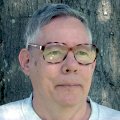 Items in this section are from TX Chapter Director Ron K5DUZ unless otherwise credited. Questions or comments should go to The East Texas QRS Net (ETN) meets each Monday evening at 1900 CDST (0000 UTC). The net has moved to 7060 KHz until next fall. The ETN net is open to all comers, not just stations in Texas, so if you hear the net in session please check-in with Allen, KA5TJS, #4512, the NCS . QRN has been really bad the last two nets and some stations couldn't be pulled out of the noise. If you were one of those stations, please try again next week. Check the weekly NAQCC net e-mail for the latest ETN info. The April NAQCC Sprint was held Tuesday evening, April 10th and once again, Robert, W5YDM, #3295 placed first in the Texas Chapter and was fourth overall. Evan, W5IQS, #3924 again placed second in the chapter and was in 11th place overall. The overall competition was again quite stiff this month and indicates that the NAQCC Sprint is becoming increasingly popular. Seven Texans participated in the Sprint this month including our very own Allen, KA5TJS. This was a nice turnout, but we can do much better. So, please make plans right now for trying your hand in the Wednesday, May 16th (Texas time) Sprint! Remember that all NAQCC members located in Texas (356 at last count) are automatically members of the Texas Chapter. We would love to hear from you about any of your recent ham activities, new QRP rig or antenna. NAQCC WESTERN PENNSYLVANIA CHAPTER:  Items in this section are from John K3WWP unless otherwise credited. Questions or comments should go to John K3WWP and Mike KC2EGL got together for one of their impromptu meetings last week. They took a long walk around Kittanning, then worked on the NAQCC prizes for a bit, and talked some astronomy. They hope to observe the transit of Venus in early June. Also they decided to do some kind of project involving an Altoids can at some point in the future, perhaps a little transmitter or maybe a keyer. Whatever it is will be written up here in the newsletter. 5. NAQCC QRS NETS: 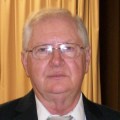 News and net reports in this section are from QRS Net Manager Gary KS4JI unless otherwise credited. Gary will handle all Net related material at this email address: From K3WWP - As you are aware, we now have a new net manager whom we welcome with open arms. Here's the first of his messages that will be appearing regularly in this section. I appreciate the opportunity to become a part of the team and everyone helping getting me settled in. Hopefully the net reports are being sent in soon after operation. We need to identify the alternate NCS for each net and insure they know to send in their reports when substituting. All of you experience interference from time to time and I know it's frustrating. Remember to move off frequency up or down a few hundred Hz and you should be able to find a clear area. You can anticipate increased activity on the nets in the near future because I am going to do my best to get the word out through many sources of who we are and where we can be found. All suggestions and comments are appreciated so let me hear from you with new ideas and opinions. 73 to all de Gary KS4JI The very latest NAQCC QRS Nets schedule can always be found on the NAQCC web site here. Recent Net Activity: NAQCC Main QRS Net (NQN) - Sunday Date(ET) NCS Participants 4-8-12 N4PLK -6- N4PLK N6TLU N4JD K1IEE K9EYT KB3ENU 4-15-12 N4PLK -11- N4PLK N4JD W4HH AC8AP K1IEE N6TLU K3NLT N1UP K9EYT N9RLO KG0YR 4-22-12 N4PLK -13- N4PLK N8IUP AC8AP N4JD N6TLU VA3PEN K1IEE KS4JI NI9Y K4AOA WB4UHC WX4RM K9EYT NAQCC East Texas QRS Net (ETN) - Monday Date(CT) NCS Participants 4-2-12 KA5TJS -5- KA5TJS KF4IBU KE5YGA KE5YUM KG0YR 4-9-12 KA5TJS -4- KA5TJS KE5YUM KE5YGA K8QI 4-16-12 KA5TJS -5- KA5TJS KE5YUM KE5YGA KF4IBU KG0YR NAQCC Rocky Mtn Regional/Continental QRS net (RMR) - Tuesday Date(MT) NCS Participants 4-17-12 WC7S -3- WC7S K1IEE KG0YR NAQCC Rocky Mtn Regional/Continental QRS net (RMR) - Thursday Date(MT) NCS Participants 4-5-12 WC7S -3- WC7S K1IEE KG0YR 4-12-12 WC7S -4- WC7S AE7CG KG0YR K1IEE 4-19-12 WC7S -4- WC7S K1IEE KG0YR AE7CG NAQCC East Coast QRS Net (ECN) - Thursday Date(ET) NCS Participants 4-5-12 K4OSO -5- K4OSO KB1WUD K1IEE K8QI KE1DX NAQCC Pacific NorthWest QRS Net (PNW) - Thursday Date(PT) NCS Participants 4-5-12 KE7LKW -3- KE7LKW K7ZPN WB4SPB 4-12-12 KE7LKW -4- KE7LKW K7ZPN WB4SPB W7MWF 4-19-12 KE7LKW -2- KE7LKW KE7ZIFor more net info, see CW Assistance/QRS Nets on the web site. 6. THE NAQCC CW ASSISTANCE (ELMER) PROJECT:  The CW Assistance project is coordinated by Ron K5DUZ. Items in this section are from Ron unless otherwise credited. If you are interested in helping out or need help with any CW and/or QRP matters contact Ron at I think it would be good to get an assistant or two for our CW ASSISTANCE PROJCT to help out Ron who is still active in the work force and frequently too busy to write up something for this section of the newsletter. If you are interested, please contact Ron at his email address above. You would need to be available to help Ron answer member's questions, and to help Ron write something for this section of each newsletter. Also anything else that Ron would have you help him with. From K3WWP - Since no one seems to want to step forward and contribute to this section, once again to keep it from being blank, I'll offer some brief thoughts on a couple subjects that can't be discussed enough. Calling CQ - The very best way to succeed in calling CQ is to keep your CQ's short, listen briefly, and repeat this sequence until you get an answer or give up. Here's a detailed example: CQ CQ CQ DE K3WWP K3WWP K Listen for a few seconds tuning up and down a few hundred Hz with your RIT If no one answers, repeat the above two steps till someone does answer or you quit. The two keys in the above are: 1 - Keep the CQ short - I (and others I'm sure) get turned off and tune away when someone calls seemingly interminable CQs before identifying themselves and listening for an answer. There is no need whatsover to send more than 3 CQs before identifying yourself. Although I normally tune away after 4 or 5 CQs, sometimes I count just out of curiosity. I've heard strings of 12, 15, even 20 CQs with no idea of who was calling. 2 - This must go along with step 1. Keep the time between your brief CQs to a few (5 or 6) seconds. That's plenty of time to listen for answers even tuning the RIT up and down for answers from the zero beat challenged folks. That way if someone catches the last few letters of your CQ (say WWP K) and is not sure if you called CQ or are in a QSO, he'll generally wait (but not long) to see which was the case. If you wait too long to repeat your CQ - guess what... he's gone along with the opportunity for a QSO. Gary mentioned this in his net comments above, and I'd like to expand on it. He said if you don't hear a net on exactly the announced frequency, tune up and down a bit. Or if you're a NCS and the net frequency is busy, move up or down slightly. It's my thought that a lot of hams who are new to CW on the HF bands might be coming from the VHF/UHF spectrum where a lot of the action is geared to exact frequencies. When they come to HF, they bring that along with them, and expect when someone says 7.045 MHz, they mean EXACTLY 7.045 MHz. They set their receiver to that frequency and lock their thinking to that EXACT frequency. Wrong! Most all mentions of frequencies on HF that don't involve Xtal control are only starting points. When a net is listed as being on 7.045, that means it may be exactly on 7.045 OR SLIGHTLY HIGHER (generally) OR LOWER than 7.045 depending on conditions at the time. Contrary to what some stubborn folks think, nets (nor any other ham activity) do not "OWN" a specific frequency, and must adjust as conditions warrant. One other example is contests. When a contest lists a frequency as 7.030 or a frequency range as 7.035-7.045, again (obviously with the single frequency) that does not mean operation is limited to that frequency or range. Those are only suggested starting spots so everyone does not spread out to all far corners of the band, but clusters AROUND (not exactly on) those frequencies. Our NAQCC sprints are a good example. Activity has increased so greatly in them, that it is often 'wall to wall' occupancy in the suggested frequency ranges. In that case, you definitely need to move outside the range, but without straying so far that you get lost. Expand outward gradually from the range until the crowding is alleviated. If you follow the above info on CQs and frequencies, your QRP operation will become much more successful. Whatever success I have had has been due in large part to the above. 7. RECENT AWARD AND PRIZE WINNERS: CERTIFICATES: Friendship Club 1000 MPW 0125 - MW0RSS - 4/2/12 0126 - G0BWG - 4/16/12 30-30 QSO-a-Day 2XQRP Alphabet Prefix USA 0012 - W9UX - 4/9/12 DXCC Category A (QRP) DXCC Category C (QRPp 50 countries) Suffix Words - SWA Category 0007 - W9UX - 4/9/12 WAC Category A (QRP) WAS Category A WAS Category B (2X QRP) WAVE Category A ENDORSEMENTS and HONOR ROLL LISTINGS: Friendship Club 0008 - NW2K - 900 points (460 members) - 4/9/12 0008 - NW2K - 1000 points (512 members) - 4/9/12 Alphabet Prefix World Alphabet Prefix USA W9UX - 101 - 4/9/12 KMPW 100 SWA Category KMPW 100 SWA/GAIN Category Suffix Words SWA W9UX - 105 - 4/9/12 WAC WAS WAVE I wonder why our awards have dwindled so much of late. All of them are fairly easy to earn, and any member can earn them. They are as cheap in price as possible - FREE. I don't have an answer, and it is very disappointing to those of us who have worked hard to come up with what we believe is a very varied awards program consisting of some standard awards with a twist, and some awards 8. MEMBER SPOTLIGHT: 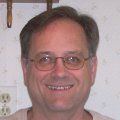 This section is managed by Paul N8XMS and any questions about it should go to Paul Tombaugh N3PDT #5443 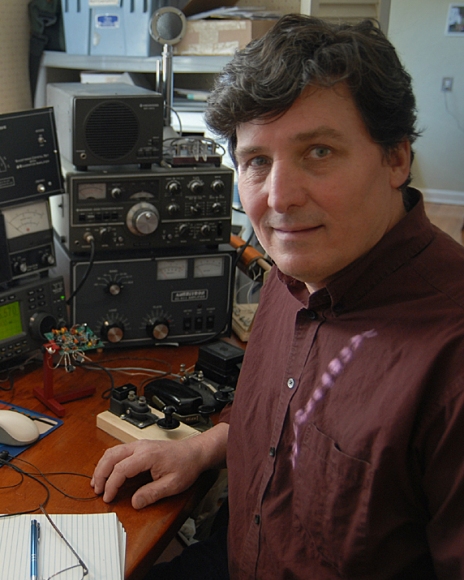 I've only held a ticket for a little over two years, but am having the time of my life. I was first introduced to the magic of amateur radio in 1969, through a Boy Scouts of America Jamboree on the Air. So, I've had a long time interest, but never did anything about it until recently. Apparently I'm part of an amateur radio trend - the mid-50s male with a long time interest in ham radio, but licensed later in life. Fast forward to Fall 2009. I stop into Associated Radio, for what, I don't even remember, and meet Bill. Bill asks if I'm a ham, and tell him the above. He replies that this is a great time to get that ticket since they recently dropped the code requirement. Light-bulb moment, and I buy some books, study up, and end up sitting for, and passing my elements 2 & 3 exams December of that same year. I dove right into HF phone. It was fun. I played with different wires in the backyard. That was fun, too. But, I soon learned that just possibly, my license privileges were earned a little to easily, and found myself "in over my head" too many times. I started challenging myself to go back and learn the stuff that I got to "skip over". I really felt that I needed to learn code, if for nothing else than the experience. So, I bought a paddle set , downloaded G4FON software, and learned code. After I learned code and got on the air, I found the straight key guys and got a straight key. After the straight key, I discovered QRP. I enjoyed QRP, so I started building kits to cover more bands. Kits led to occasional portable operations and more antenna making. By that time, I didn't even know where my mic was, and didn't care. (I did finally discover the mic when we moved into this house last November.) I found NAQCC through a sprint announcement on eHam, or on the SKCC reflector, I don't remember which now. Until then, I had only worked a few low-key sprints, and none with the rigorous log cross checking of NAQCC. First NAQCC sprint out was the first time I had a contact busted. That felt a little weird at first, but that quickly turned in to another light-bulb moment. I liked it. I set a goal for no busted calls my next NAQCC sprint, and achieved it. It took me another couple sprints before I saw my call in the Golden Log list. That felt pretty good too. Unfortunately, work has kept me from participating in sprints, but I'm seeing this as an opportunity to participate in the other NAQCC activities, especially the Friendship Club and the prefix and suffix words. I enjoy meeting new folks and just having a chat about anything, radio related or not. I look forward to working you on the air soon. 9. NEWS ITEMS AND ARTICLES BY OUR MEMBERS: 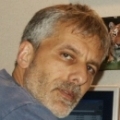 This section is a forum for you to tell other members what you've been up to on the ham bands or to submit an article dealing with some aspect of CW and QRP operation or equipment. Examples might include, but not limited to, antenna projects, QRP and/or SDR equipment, tuners, battery technology, keyers, logging, or other related topic of interest to the QRP community. Send your news items and articles to our news editor Paul KD2MX at 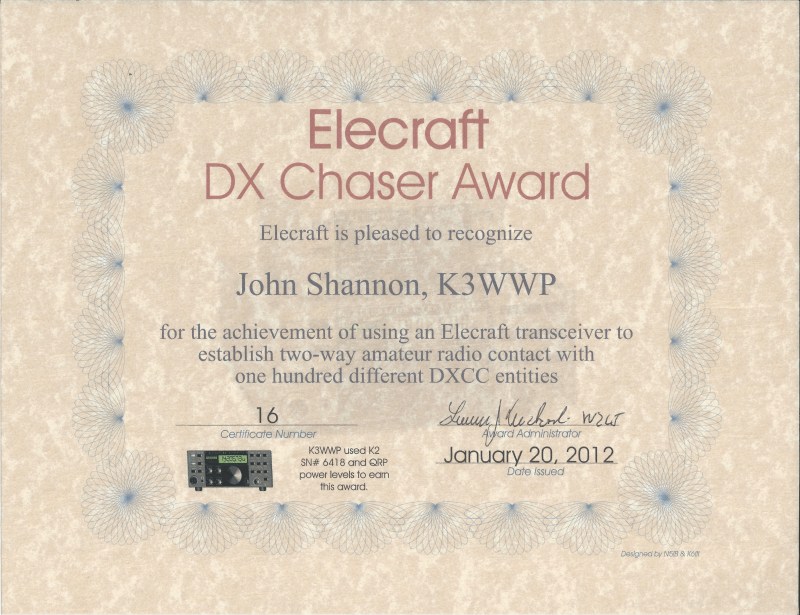 First, I learned a lot about colors. I have learned that there are colors with names that I have never heard of. I've learned that the color of the carpet in the church is important and has a direct impact on dresses, flowers, bows, candles, makeup, and for all I know, even the national economy. Most importantly, I have learned that I have no sense of what colors "go together". This is evidenced by the apparent fact that the grey and black color motif of my Elecraft K2 doesn't really "go with anything". I'm not sure, but this might have a direct bearing on the second lesson that I learned. My second lesson is that even though a wedding is called a "special event", a special event QRP operation from the reception was not considered appropriate by the ladies in charge! I checked things out very carefully. The reception hall had a very high ceiling with plenty of nice supports for putting up a multiband dipole fed with ladder-line. A small table near the cake would have been a great operating location and we could easily dress it up with a few flowers in colors that would go with the gear. And since we would be using CW there would be no real issues with violating FCC rules by accidently broadcasting the background music in the hall over the ham bands. I knew that I couldn't really match some of the special event operations that have been done for the royal weddings over in England. But I thought that we could probably make a couple hundred contacts and print up a nice QSL card with a picture of the happy couple on it. The wedding coordinator had a strange look on her face and my wife and daughter said in unison, "just ignore him, he's a ham." The third ham radio lesson that I learned is that weddings are very expensive and are a lot like an Elecraft K3 - the base price sounds OK but there is an unending list of accessories, and each one comes with another price tag! I will be operating in our sprints with my same old rig and antenna for the foreseeable future. Well, as I said, the insanity is over. My daughter and her husband are on their honeymoon, and I am hoping to actually find the time to complete our monthly operating challenge. My check-writing hand has developed a little bit of carpel tunnel syndrome so please forgive my poor sounding fist. (From K3WWP - That's a sad statement but apparently true. After all the work that goes into creating a fine web site over the years for the NAQCC, a lot of members have never taken the time to explore it, or even look at it. They must think these newsletters ARE the NAQCC. If that describes you, PLEASE take the time to go to http://naqcc.info/ and look around, then bookmark it or add it to your favorites. - Thanks) Thus, I'm embarrassed to say I have only 14 QSOs in the logbook in the past six months, all CW QRP (5 watts). My station is far from elaborate: I own a seven-year-old Icom IC-718 with DSP; an old, used Speed-X straight key, a 30+ year-old Ten-Tec antenna tuner, and my antenna "farm" is a yawner comparred to most hams: a 7-year-old off-center-fed folded dipole (180' x 90') that is bent in a weird configuration (NW by E) and only a little over 20 feet off the ground. Among my 14 QSOs: Iceland, St. Petersburgh, Russia, Antigua & Barbuda; Cayman Islands, Croatia, and all over the US including a guy in Wampum, Wisconsin who was running just 1 watt! Now that I'm working only one job....my own business. I fully expect to spend a bit more time on the bands from now on. Computers, cell phones, and other electronic conveniences are all useful and great tools. And I understand not every ham will agree, but for this baby-boomer I love my ham radio hobby using the oldest mode: CW, running QRP with a simple wire antenna. Every day that I am able to get on the bands is fun, and a challenge. You gotta love it! 73's. This new equipment has given rise to great changes, not only to the modern day transceiver with its built-in screens and ability to decode data, but includes keyboards, digital mode software, logging programs and so much more that today help us in our quest to communicate. 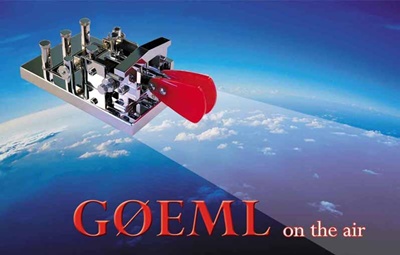 However I do feel very surprised when, after over nine years of using the GHD range of photo-diode-based telegraphy paddles, I inform others during a CW contact that I am using a state-of-the-art communication key, and many of these hams profess that they have never heard of it. This optical paddle uses light diodes for the contacts instead of the standard silver or platinum. I first got my license in 1985 as G1RKB, the letters relating to my name. I set about not only to learn and understand the skills of a modern day telegraphy operator but to master the finer points that are essential in being a good CW operator, and yes I am still learning and trying. One of the first and most outstanding books that I became aware of was by Bill Pierpont N0HFF, now a silent key. This book for me is the bible of CW and it is now available as a free download. The Art and Skill of Radiotelegraphy. We are all at least somewhat aware of our historical past with the 1844 birth of the key. This wonderful episode in history included Samuel Morse, along with his assistant Alfred Vail, sending the first official Morse code from Baltimore to Washington, DC. This was a demonstration of the Correspondent Key, and within six months Vail had perfected the principal on which all keys have since been based. Having armed myself with books on telegraphy, keys and sounders, I learned about the lever correspondent key. Then I discovered keys with strange names like the camel-back, side swiper and bug. What strange but mystical world was I getting myself into? Great names of our past began flooding through my mind; Bunnel, McElroy, and Martin, to name but a few. Horace G. Martin was known all over the world for the fine quality and outstanding range of his Vibroplex keys and semi-automatic bugs. I learned that Martin produced, in 1903, his first Autoplex key. Even as his new key was being sold to telegraphers, Martin was working on a radically improved model which he called the Vibroplex Original. All the early Vibroplex keys were custom built by Martin in a small shop in Brooklyn, NY. During the years 1903 to 1960, the Vibroplex company produced over 16 models of semi-automatic keys and bugs, more than any other manufacturer. Then in 1979, the first iambic key was produced by Vibroplex, with their twin lever classic. I have heard it said that this key had a jewel movement, perhaps for better manipulation. Even though the owners of the Vibroplex company have changed a number of times over the years, the company is still producing paddles and keys today, with many different models available Vibroplex keys are much sort after by collectors and morse enthusiasts from all corners of the globe, and have given me much sought after inspiration. For those who wish to know more about the Vibroplex keys and their associated history, you can consult "The Vibroplex Collectors Guide", by Tom French. Like an illness and the plague I began searching anywhere I could in order to satisfy my desire to learn more, including old book shops, the internet, radio clubs, and you name it. I came across the world speed champion of telegraphy receiving, the great Theodore Roosevelt McElroy. McElroy was a native of Boston, Massachusetts. Even before he became world speed champion, this young lad, at the tender young age of fifteen years, could type on a typewriter at the amazing speed of 150 wpm, a much greater speed than his school teacher. Perhaps you have heard of Ted, as that is what he liked to be called. He was named after the president at the time, Theodore Roosevelt, and he was to become the world speed CW Champion, setting on July 2, 1939, the record of 75.2 WPM. McElroy's skills were so entertaining that he would tour the states doing shows. One of his favorite stunts was to pause in the middle of a high speed morse receiving run, possibly take a drink or even a smoke, and then continue to copy without missing a word. This ability to copy in your head is not unknown by today's amateur CW operators, but just think for a moment! Ted was typing from memory, then storing the additional text received in his head until his typing had caught up. I recommend the book about his life and skills , "McElroy, World's Champion Radio Telegrapher" also by Tom French. It is a very interesting and informative read. In addition, McElroy became a well known manufacturer of fine keys, now much sought after by collectors. He sold his keys under the name of Mac-Keys. Not quite so well known is that McElroy also became a licensed radio amateur with the call sign, W1JYN. McElroy said it should have been G-I-N as that was his favorite drink. From 1936 through World War II, McElroy teamed up with Reginald Adams, G2NO of Wolverhampton England, to meet demand for his keys. They had a very good business with an efficient delivery of American radio products to Adams' shop, which was named Eve's Radio LTD. The two became very good friends and Adams used their keys in action as a SOE agent during the war. By 1944, Reg Adams had risen to the rank of major in the SOE, and was in charge of the wireless section of Poland, Czechoslovakia and Hungary. Also in 1936, McElroy joined a partnership and helped set up the Telegraph Apparatus Company of Chicago USA. I have one of these keys mounted on a Mac-Key base, namely the CP500 Base. It is a very heavy and sturdy bug that feels good to the operator and won't move during operation. It is said that this was one of the very first semi-automatic keys to become available in kit form. The S-600 super stream speed key, produced in 1941, is not the scarcest Mac-key but to collectors, it is one of the most desirable. It was not until 1939 that we were to see the introduction of the fully automatic key, which was developed by Melvin E Hanson, W6MFY of California. Advertised as the Melehan Valiant, it was actually two complete separate units mounted on one base. One unit was to make the dots and the other would create a series of dashes. The mainspring on a pendulum achieved the dash time, thus making the spring attached to the pendulum three times longer than the dot spring. These were true classics right from the start. Approximately 500 Valiants were personally made by Hanson or his assistant at the The Schultz Tool and Machine Manufacturing Company in California. Vibroplex finally joined the electronic revolution by producing the Vibro-keyer a single lever paddle with its parts all coming from the original Bug and Base. On construction, a small phillips screw would fill the tapped hole in the left arm where the bugs lever stop screw would have gone. As I mentioned earlier, it was not until 1979 that Vibroplex was to introduce the Iambic, as the name states it was a dual lever electronic keyer paddle. The early models show that the original Bug frame was still being used with the tapped hole in the left arm intended for the bug's main lever return spring adjustment screw. Over the years there have been many instrument makers turned Key and Paddle Makers, far too many for me to mention. But I am sure that you are familiar with such names as Begali of Italy, Schurr of Germany, Samson of Germany, Bencher of USA, Hi-mound of Japan, and GHD by JA7GHD. And we have many UK key makers that can hold their place within the world of keys such as Kent of Preston, Chevron by M0AGA, TW-Magpad by G3HGE, G4ZPY Keys by Gordon Crowhurst, Derick Stillwell, instrument key maker, Shrewsbury. I own and use keys by all the above, to name just a few. But what makes a good key or paddle? I have found that what suits one CW operator may not suit another. It comes down to personnel preference, some like a light touch and feel to the levers whilst others like a firmer feel or touch. So why do so many radio operators have so many different keys/paddles within their collection? Having asked this question to a number of CW operators, I can say that the historical collector likes the feel and thoughts of the historical past. It is said for some it is like driving an old vintage car with a sloppy gear change, while another old car may have tight robust heavy steering. Some of us like to hold and feel the past as one would hold some historical vintage jewel. But for whatever the reason, the cars of today have much better performance, and that can also be said of some of our modern day keys and paddles, especially with the introduction of magnetic and optical light diode based paddles. Dual lever bugs were introduced as early as 1910 and represented a significant advancement in the art of telegraphy. That is because a dual bug can be operated at a much higher speed than a single lever bug and with better flow and rhythm. So it is in some ways ironic that these two of the most significant advances in the technology had to wait for the end of the 20th century.  The year 1990 saw the introduction of a new magnetic paddle, the phenomenal Mercury Paddle , by Steve(Stefan) Nurkiewicz, N2DAN. With a new and interesting type of contact adjustment, these beautiful hand-made paddles used magnets instead of springs to adjust the arm tension. Steve was born in Poland but after the war he settled in the United States. During the war, he had worked under cover with the British Royal signals regiment and also as a SOE Agent. I often wonder if Steve named the paddle the mercury paddle due to the fact that the cap badge of the royal signals regiment is the Roman God, Mercury? Radio amateur enthusiasts started to become more interested in the modern concept of paddles and the computerized electronic keyer. New innovations and applications including the modern day optical sensor replaced the standard silver contacts of the paddle key. In addition, to this modern key came the introduction of a simple convertible dual or single lever paddle operation, i.e. you can, via a simple screw, adjust the paddle from twin lever operation to single paddle use. We have come a long way from the standard adjustment and principle of the correspondent key with its bent spring made from steel which is used to return the key to the rest position. This mechanism was eventually replaced by the coil spring invented by Thomas Avairy. We are familiar with how magnets can be used to attract or repel the key levers, giving the operator a lighter softer feel during the manipulation process than can be found with standard keys. Many key makers over the years have produced keys with the standard and renowned concept of using the commonly known method of the contacts to produce the dot or dash. I know of only one person that has broken with tradition to offer the state-of-the-art and modern day choices to the CW operator. And that is Toshihko Ujiie, JA7GHD, founder and principle of the GHD company in Sendai City, Japan. Toshihko shares his love and enthusiasm for the hobby of Morse code through his products. Today there are few paddles, keys and bugs which generate as much excitement as the range of GHD products. Over the years, GHD has made over 40 individual styles of keys, paddles and bugs. His keys are of outstanding quality, highly chromed, and they manipulate with ease. These amazing pieces of manipulation machinery are beautiful, practical and innovative. I first became aware of GHD Keys in 1997 via the Key Letter, a morse enthusiast's magazine produced by Lynn Burlingame N7CFO and then published in the United States but no longer in production. The first model that I used was the GD301. This model is considered to be a multi-key. That is, it can be used as a bug or keyer paddle. The paddles that I own can be converted from dual to single lever operation. To date I have owned and used five models of GHD paddles, two optical models and three mechanical. 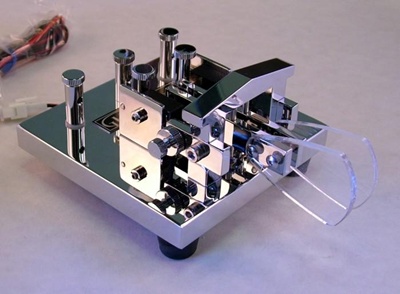 The GHD optical model paddles or bugs use photo diodes instead of mechanical contacts to make the dots/dashes, In order for this to be achieved, a simple, thin, twin lead supplies 12vdc via a tiny circuit board mounted underneath the paddle or bug. The optical components gives rise to a smooth effortless manipulation of the selected paddle model due to the fact that there are no physical contacts with the optical light diode. GHD used to make a whole range of products, from straight keys (both leaf spring and sealed ball-bearing type) to bugs and paddles with optical contacts. Unfortunately due to shipping costs and a high standard of workmanship, the price of their keys are a little expensive, but in my opinion they are well worth it. Over the past few years the GHD WS series, a lever mechanism that can be converted from dual to single lever operation, has replaced the earlier and discrete single and dual lever models. Over the years GHD has reduced its product range greatly and I feel soon they will soon become unavailable. For those that may be interested you can find videos showing many of these paddles and keys on YouTube. There are a large group of old timers out there who have grown up with bugs and other types of older keys, often using them daily in a professional manner or possibly with the military, and who are still today keeping the art and science of Morse telegraphy alive. But fortunately there is also a growing body of modern day radio amateur enthusiasts who are fascinated not only by the older techniques and skills but by the modern optical photo diode and magnetic keyer paddles of today. I feel these keys will be well sought after by collectors and will find a place in the history of the key. I hope this review of history and introduction to the modern day optical and magnetic paddles; along with the skill, flair, and of course the ability of our CW operators, will help continue the appreciation and art of CW. | ||||||||||||||||||||||||||||||||||||||||||||||||||||||||||||||||||||||||||||||||||||||||
| All comments on specific sections of the newsletter should go to the email address given in that section. Any other general comments go to: The publication of our next newsletter will be announced via email to all members for whom we have a valid email address unless you specifically have unsubscribed from the email. Past on-line newsletters beginning with issue #042 are now archived and INDEXED on the site. So if you missed seeing any past issues, you can check them out in the archives. Unless otherwise credited, all items are written by K3WWP. If you came directly to this newsletter, we invite you now to browse the NAQCC Web Site. | ||||||||||||||||||||||||||||||||||||||||||||||||||||||||||||||||||||||||||||||||||||||||